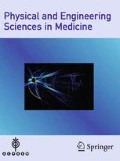Abstract
Alignment between the radiation isocenter and imaging isocenter is critical to ensure accurate proton dose deposition in the patient. The purpose of the current study is to perform a comprehensive evaluation of the coincidence (planar kV X-rays vs. pencil proton beam) among three, beam-matched pencil beam scanning (PBS) gantries of a ProteusPLUS proton therapy system. For proton radiation isocenter measurement, a cone-shaped scintillator detector, XRV-124, was utilized. To test the impact of gantry angle on the beam coincidence, measurements at 12 different gantry angles were performed in the study. Additionally, the energy dependency on beam coincidence was investigated by acquiring measurements for a total of 63 different energies ranging from 70─225 MeV at increments of 2.5 MeV. The measurements were performed in all three beam-matched gantries (GTR1, GTR2, and GTR3). A correction of ≤ 0.3 mm was applied in the imaging system to account for the imaging isocenter shift as the gantry rotates from 0° to 330°. The beam coincidences in X, Y, and Z were within ± 1.0 mm for 63 different energies at 12 different gantry angles in all three beam-matched gantries. The beam coincidence results among three gantries (GTR1, GTR2, and GTR3) ranged from − 0.9 to 0.7 mm in the lateral (X), − 0.8 to 0.5 mm in the longitudinal (Y), and − 0.7 to 0.7 mm in the vertical (Z) directions. Overall, the mean isofocus of radiation isocenter was 0.4 ± 0.2 mm in GTR1, 0.5 ± 0.2 mm in GTR2, and 0.4 ± 0.2 mm in GTR3. Given the consistent agreement (< 1.0 mm) between radiation and imaging isocenters for all three rooms, it appears feasible to confidently generate proton treatment plans for one treatment room and deliver in the other beam-matched rooms.






References
Moyers MF, Lesyna W (2004) Isocenter characteristics of an external ring proton gantry. Int J Radiat Oncol Biol Phys 60(5):1622–1630
Pidikiti R, Patel BC, Maynard MR, Dugas JP, Syh J, Sahoo N, Wu HT, Rosen LR (2018) Commissioning of the world's first compact pencil-beam scanning proton therapy system. J Appl Clin Med Phys 19(1):94–105
Fuse H, Sakae T, Terunuma T, Sato M, Aoki S (2012) An isocenter detection and verification device for use in proton therapy. Rev Sci Instrum 83(12):125109. https://doi.org/10.1063/1.4771576
Ding X , Zheng Y, Zeidan O (2013) A novel daily QA system for proton therapy. J Appl Clin Med Phys 14:115–126
Cai W, Oesten H, Clasie B, Winey B, Jee KW (2019) Semi-automated IGRT QA using a cone-shaped scintillator screen detector for proton pencil beam scanning treatments. Phys Med Biol 64(8):085004
Rana S, Bennouna J, Samuel EJJ, Gutierrez AN (2019) Development and long-term stability of a comprehensive daily QA program for a modern pencil beam scanning (PBS) proton therapy delivery system. J Appl Clin Med Phys 20(4):29–44
Lin L, Ainsley CG, Solberg TD, McDonough JE (2014) Experimental characterization of two-dimensional spot profiles for two proton pencil beam scanning nozzles. Phys Med Biol 59(2):493–504
Lin L, Ainsley CG, Mertens T, Wilde De O, Talla PT, McDonough JE (2013) A novel technique for measuring the low-dose envelope of pencil-beam scanning spot profiles. Phys Med Biol 58(12):N171–180
BeamWorks™ for the XRV-100 and XRV-124 User Manual; Version 2.31
Rana S, Samuel EJJ (2019) Feasibility study of utilizing XRV-124 scintillation detector for quality assurance of spot profile in pencil beam scanning proton therapy. Phys Med 66:15–20
Acknowledgements
The authors would like to thank the IBA Particle Therapy Team at the Miami Cancer Institute (Eric Jensen, Manuel Ubau, Hassan Imrane, and Dar Patel) for providing us the information on the radiation isocenter alignment process on an IBA ProteusPLUS PBS machine. Also, we want to thank Victor Chirinos for assisting us in taking some of the measurements in this study.
Funding
This study does not include any funding.
Author information
Authors and Affiliations
Corresponding author
Ethics declarations
Conflict of interest
All authors declare no relevant conflict of interest.
Ethical approval
This article does not contain any studies with human participants or animals performed by any of the authors.
Additional information
Publisher's Note
Springer Nature remains neutral with regard to jurisdictional claims in published maps and institutional affiliations.
Rights and permissions
About this article
Cite this article
Rana, S., Bennouna, J., Samuel, E.J.J. et al. Quantification of radiation and imaging isocenter coincidence of a multi-room PBS proton therapy system. Phys Eng Sci Med 43, 279–288 (2020). https://doi.org/10.1007/s13246-020-00841-y
Received:
Accepted:
Published:
Issue Date:
DOI: https://doi.org/10.1007/s13246-020-00841-y

